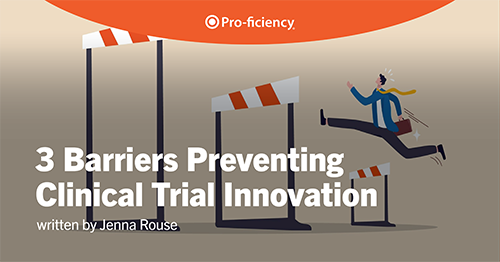3 Barriers Preventing Clinical Trial Innovation
The move to more decentralized trials in response to restrictions imposed by the COVID-19 pandemic illustrated that the clinical trial industry is well able to take new technology on board and adapt it to use in the conduct of studies. But outside that example, the industry has been and largely remains resistant to any types of change, including the adopting of new technologies, even when such technologies offer clear time or cost benefits.
Although adoption of new technology and innovation has seen a rapid rise in the world at large over the last decade, organizations that lag in adopting new technology and new ways of doing things are more common than not in the clinical research industry. A recent survey by the Tufts Center for the Study of Drug Development (CSDD) indicated that innovations in the clinical trial arena take nearly six years to adopt. Planning and initiation of an innovation can take almost 14 months, with evaluation of viability and impact takes nearly 16 months. Another 16 months may be spent deciding whether to move forward with an innovation; it can then take 23 months to implement it.
“The timeframe to go through each stage of the process varies by company size, but overall, respondents report the later stages of the process—deciding to adopt the change and implementing it—are the most difficult,” the report said.
The CSDD survey results, published in the center’s July/August 2022 Impact Report, indicated that while 67.8% of respondents rated their companies’ abilities to adopt innovations as “excellent” or “good,” 60% also report that their companies are slower to adopt those innovations compared to similar organizations.
Many other professions demonstrate a much higher degree of adaptability and willingness to adopt new technologies and new approaches to getting things done. For example, schools from elementary through college levels had to pivot quickly to remote learning during the pandemic, and most did so with aplomb.
And the clinical research industry likewise demonstrated during the pandemic that it is capable of making swift, agile changes to cope with unusual circumstances. With COVID driving efforts to socially distance and avoid people gathering indoors, research sites, sponsors and CROs quickly folded in use of various technologies—telehealth, passive data gathering via wearables, remote health visits and more—to allow a decentralized approach to clinical trials. And the approaches taken to address the need to keep patients out of research sites during the pandemic have been successfully applied to provide more flexibility to how patients experience clinical research.
Regulatory uncertainty worries researchers
But where does this resistance come from and what are its impacts? Three deeply ingrained institutional barriers appear to be at work.
The first of these is grounded in regulatory obligations. The clinical research industry is one of the most highly regulated in the world, and this is the root of the second primary barrier to change acceptance. Due to the myriad regulations that clinical researchers must follow, there is a very real fear that any changes—no matter how useful or well-intended—could lead to problems with the FDA.
The CSDD survey listed lack of regulatory clarity as a significant barrier to adoption of innovations. The regulatory and legal departments in research organizations may be hesitant to adopt new technology or approaches due to vagueness in current laws and regulations, for instance.
Additionally, the FDA and other global regulators showed themselves equally flexible in taking on board novel technologies and methods to allow this shift; the FDA even issued guidances explaining how these new approaches fit into the existing regulatory scheme. This experience could ultimately be a driver to more acceptance to changes in technology used in clinical research.
A permeating attitude of “if it ain’t broke, don’t fix it” underlies this concern. Due to regulatory and risk aversion, the industry as a whole is unmotivated to make any changes that are not mandated. Even if a new technology or approach could make part of an operation cheaper, any uncertainty or risk or even lack of proven effectiveness can be enough to prevent a research site or other organization from even considering adoption of new technologies or other changes.
And this can be rather short-sighted. For example, non-compliance with the protocol is consistently the most-common observation during FDA inspections. And whether a protocol deviation is noted during an inspection or not, it can still lead to delays and added costs, such as those associated with retraining erring staff—and sometimes all staff.
This is an acknowledged problem that occurs with relative frequency. In a paper published in April of this year, for instance, CSDD reported results of a working group study, which showed that Phase II and III protocols have a mean total of 75 and 119 protocol deviations, respectively. These figures potentially involve nearly a third of all patients enrolled in a clinical trial.
And they should indicate to research sites, sponsors and CROs that something is, in fact, broken in the current system, likely linked to the way in which research staff receive protocol training. That is, in itself, a strong indicator that the industry needs to do something different from what has been done in the past.
For example, in terms of improving researchers’ performance in protocol compliance, training is an obvious place to look. Decades of providing massive slide decks and lecture-based training has not yielded greater protocol compliance. Simulation-based training, which has proven more effective in teaching concrete skills in the medical, airline and other industries, has been gaining some traction in the clinical research sphere recently.
Research staff burdens concern sites
A second key barrier to technology and innovation adoption lies with growing concerns about the workloads imposed on research staff. Many employees are staggering under existing workloads; with trials seeing increasing complexity and the emergence of new approaches like decentralized and hybrid trials, many research positions are having tasks added frequently.
And technology burnout, in particular, is a common complaint among research sites, as well as CROs and sponsors. Many feel there is an overabundance of technology, leading to tech burnout. This has made sites and sponsors reluctant to add yet another log-in and password to staff’s plates. Going back to the training example, sending a slide deck or link to a webinar via email is one less system for sites to log into and can appear on the surface to reduce staff burden.
But a change in this area could ultimately reduce site staff burden if approached properly. In the area of training, for instance, changes from the familiar delivery of slide decks, with or without an accompanying lecture, might be viewed skeptically due to fear that this would add more time to already-long workdays, without accompanying payment that might take the sting out of extra work.
But simulation-based training that generates immediate information about staff performance in lifelike scenarios could allow staff to fly through parts of the training in which they are already proficient and allow them to focus more closely on areas specific to a given protocol where they may require more guidance. This could include things like a procedure that is different from standard of care or a particular way of gathering data that may be unfamiliar.
And while it’s important to consider the impact of any change on researchers’ time, it’s equally critical to ensure that both individual employees and the clinical trial as a whole are actually benefiting from a chosen technology or method. Technology tools, such as simulation-based learning, are not a gimmick. In fact, they should be developed to help the learning spectrum and improve staff performance by ensuring that all employees have full understanding of the requirements of a protocol.
Uncertain returns on investment hinder change
And the third main barrier to needed changes in the clinical research industry is simply institutional uncertainty about the potential benefits and impact of adoption of new technology, new approaches and new training, among other changes. The CSDD survey also pointed to the challenge of return-on-investment assessments as a barrier to innovation in the industry.
Changes must both have some sort of defined and measurable reward and be fairly certain of not causing negative consequences. Changes in one aspect of clinical research can impact many other aspects. And that means changes can be costly from an investment and potential loss standpoint.
This ties back into the fear of something going wrong such as a regulatory or legal consequence, or additional cost or time required. If something has been done the same way and there were no serious problems—e.g., there was no regulatory fallout, no patients were harmed, no-one got fired—organizations may be loathe to risk problems if they take a chance with a new technology or approach.
And the complex interplay among research sites, sponsors, CROs and often multiple regulatory bodies, along with IRBs means there are a lot of moving parts to evaluate. The challenge of an effective risk-benefit analysis may be, in some cases, deemed to take too much time and money, not to mention staff resources, to complete properly. In such cases, the risk of a change causing regulatory problems—despite recent FDA signals of flexibility in areas of new technology use—will often tend to tip the vote in favor of the status quo.
A closely tied concern for researchers is change management; many sites lack efficient, established procedures for evaluating and implementing changes. But that means that, in addition to allowing greater time and cost efficiency, more patient-focused approaches to research and reduced protocol deviations, the effort towards incorporating appropriate new technology or operational approaches could also lead to improved change management processes. This, in turn, would make it safer and simpler for organizations to adopt new innovations in the future.
In a nutshell, it’s easier and less scary to keep doing things the same way. But many burgeoning technologies can be folded into the clinical trial process in a way that gives back more than they take. Shifting to simulation-based training in place of slide decks, for instance, can ultimately reduce the amount of time spent on training activities while improving a long-standing weak area—protocol compliance.
Change can improve many situations, and when new technology or new approaches show clear rewards, they should be considered.

As Chief Experience Officer at Pro-ficiency, Jenna helps clients realize the full potential of their partnership with Pro-ficiency. Jenna has spent 16 years at the Association of Clinical Research Professionals (ACRP), including serving in various roles such as Business Development leader. Throughout her time at ACRP she helped hundreds of companies integrate competency-based learning, hosted by Pro-ficiency, into their workforce initiatives. In this work, Jenna began noticing her clients’ appreciation for the incredible Pro-ficiency platform, simulations, and customer service. Now, Jenna helps clients (including ACRP) realize the full potential of their partnership with Pro-ficiency.



Comments are closed.